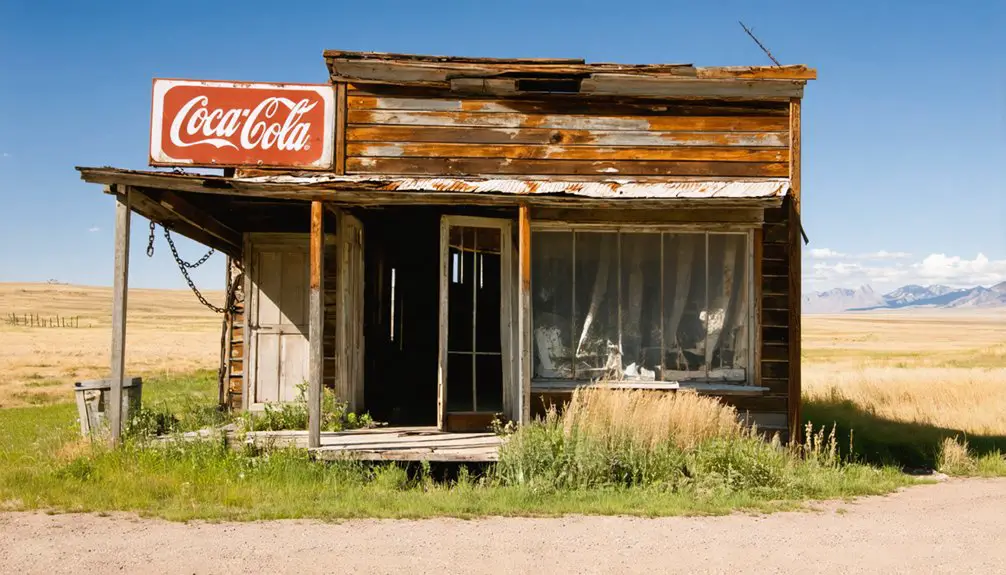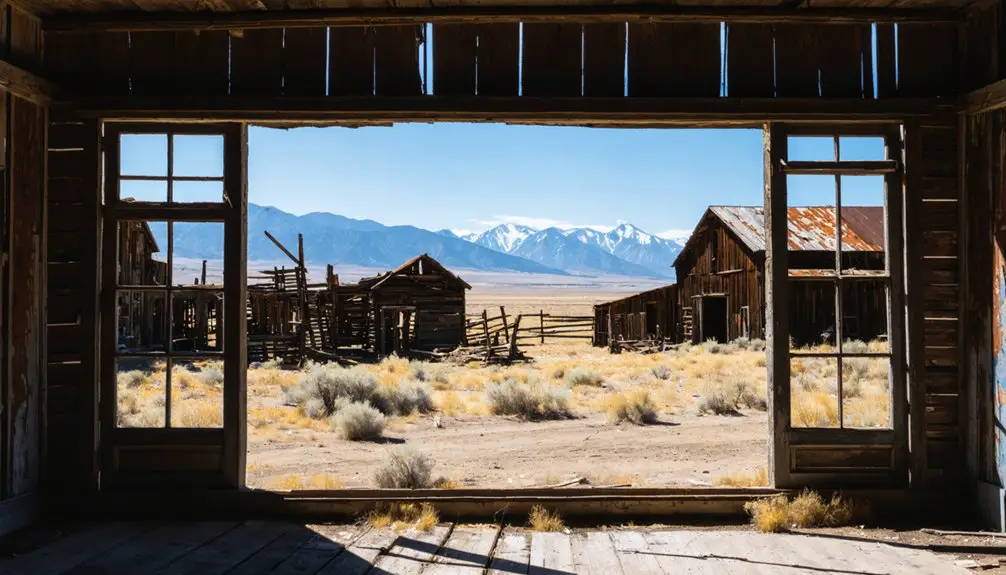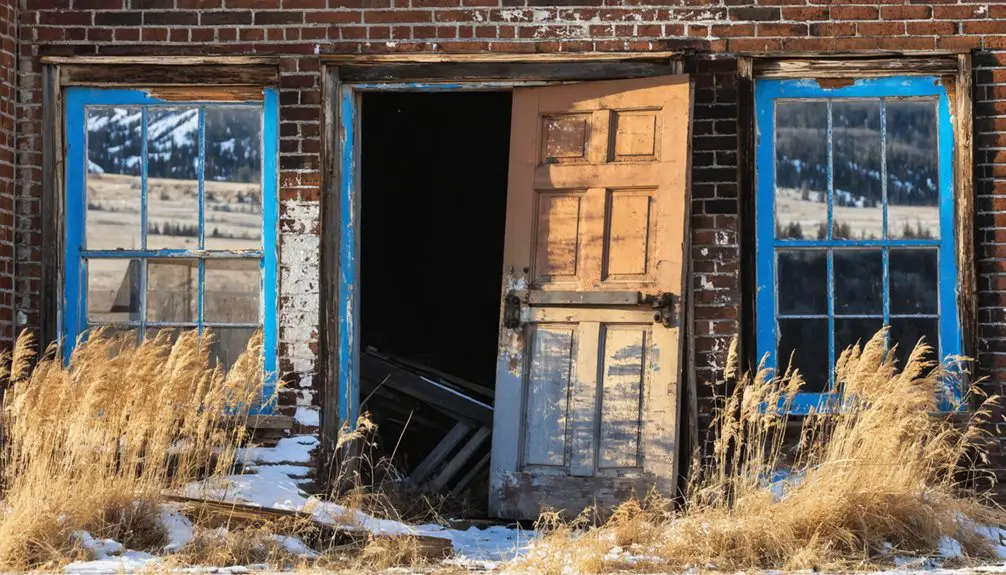You’ll find Vandalia’s haunting remains in Valley County, Montana, where this once-thriving prairie town flourished in the early 1900s. The ghost town showcases deteriorating structures from its heyday, including a prominent two-story brick schoolhouse that educated 100 students until 1959. The town’s growth stemmed from its bustling brick factory, sheep farming, and strategic location along the Great Northern Railway. Vandalia’s forgotten buildings and irrigation remnants tell a fascinating story of boom-and-bust frontier life.
Key Takeaways
- Vandalia was a thriving early 20th-century Montana prairie town supported by brick manufacturing, sheep farming, and railway connections.
- The town’s name originated from a legendary raid on a Great Northern Railway survey camp by vandals.
- Its iconic two-story brick schoolhouse, which operated until 1959, remains one of Montana’s most photographed abandoned structures.
- The Walsh Fire Clay Products Company brick plant was once the world’s largest, producing 2,500 metric tons monthly.
- Modern Vandalia is a ghost town with deteriorating structures, though preservation efforts continue through venues like Gunslinger Gulch.
The Rise and Fall of a Prairie Town
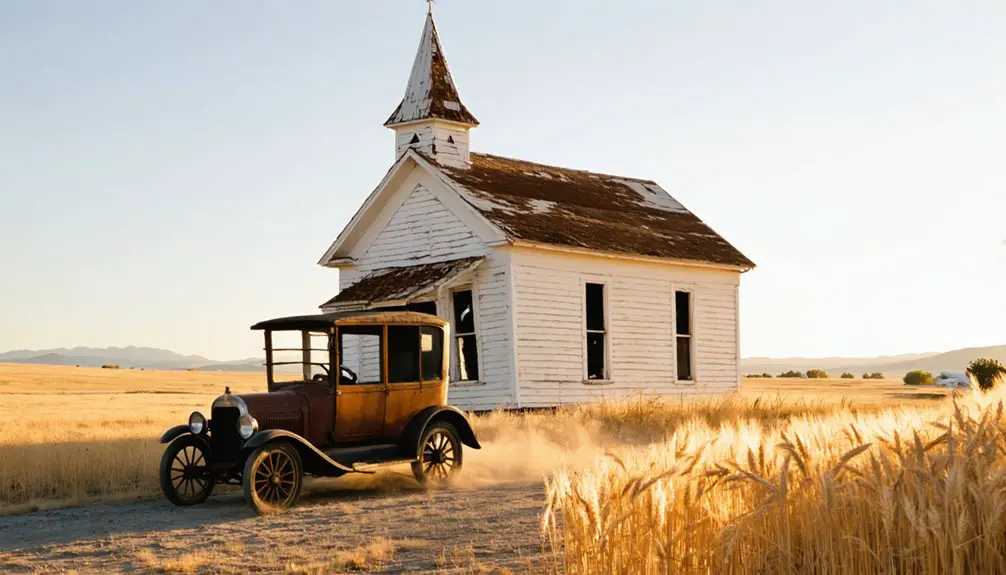
As homesteaders pushed westward in the early 20th century, the small prairie town of Vandalia emerged in Montana’s Valley County, marking another foothold of civilization along the Great Northern Railway.
You’d have found a bustling brick factory and thriving sheep farms driving the Vandalia economy, while the Milk River’s irrigation projects transformed the harsh prairie into farmable land.
The town’s proximity to the railway and larger settlements helped sustain its modest growth, with community events bringing together isolated farming families. Like many settlements near Thoeny ghost town, Vandalia represented the dreams of hardy pioneers willing to stake their claim on Montana’s frontier.
Railway connections and nearby towns fostered Vandalia’s growth, while local gatherings united scattered homesteaders across the prairie.
Despite these advantages, Vandalia couldn’t overcome the harsh realities of prairie life.
As irrigation challenges mounted and the Glasgow Air Force Base’s eventual closure shifted regional dynamics, you’d have witnessed the town’s gradual decline, watching as residents departed for more promising opportunities elsewhere.
Life Along the Milk River
As you explore Vandalia’s early history along the Milk River, you’ll discover how settlers in the 1910s relied on small-scale irrigation projects to cultivate crops in the semi-arid prairie.
You’ll notice remnants of the simple canal systems that once channeled water from the Milk River to scattered homesteads, where families struggled to maintain consistent water flow during the region’s unpredictable drought cycles.
Life centered around the river’s seasonal patterns, with residents gathering at swimming holes during hot Montana summers and hauling ice blocks from the frozen waterway in winter.
Early Irrigation Settlement History
While the Milk River Project transformed northeastern Montana’s agricultural landscape after 1902, its implementation marked one of the Bureau of Reclamation’s most ambitious early ventures.
You’d have seen irrigation technology reshape the semi-arid plains through 219 miles of main canals and hundreds of miles of secondary waterways, converting former dryland ranches into productive farmland.
Settlement patterns followed the water’s path, with Vandalia emerging as a key outpost in 1904 under rancher H.H. Nelson’s leadership.
The project wasn’t without its challenges – you’d have witnessed disputes over water rights with Native Americans and international negotiations with Canada before construction could begin in earnest.
Despite sinkholes and porous soil conditions that demanded constant maintenance, the irrigation system ultimately enabled farmers to cultivate hay and grain crops on previously marginal lands.
River Community Daily Life
Three essential elements shaped daily life along the Milk River: agriculture, community cooperation, and water management.
You’d find settlers organizing shared labor for irrigation maintenance while adapting their daily farming routines to water availability from Lake Sherburne’s reservoir releases.
River community interactions centered around agricultural hubs like the Phillips County Fairgrounds near Dodson.
Your life along the Milk River would’ve revolved around:
- Working the fertile valley lands, growing hardy grains and alfalfa
- Trading livestock and sharing farming resources with neighbors
- Gathering at railroad section houses and water tanks for social connection
The wide river valley, with its cottonwood groves and natural springs, supported your farming success through carefully managed irrigation systems spanning 120,000 acres of productive land.
Origins of the Vandalia Name
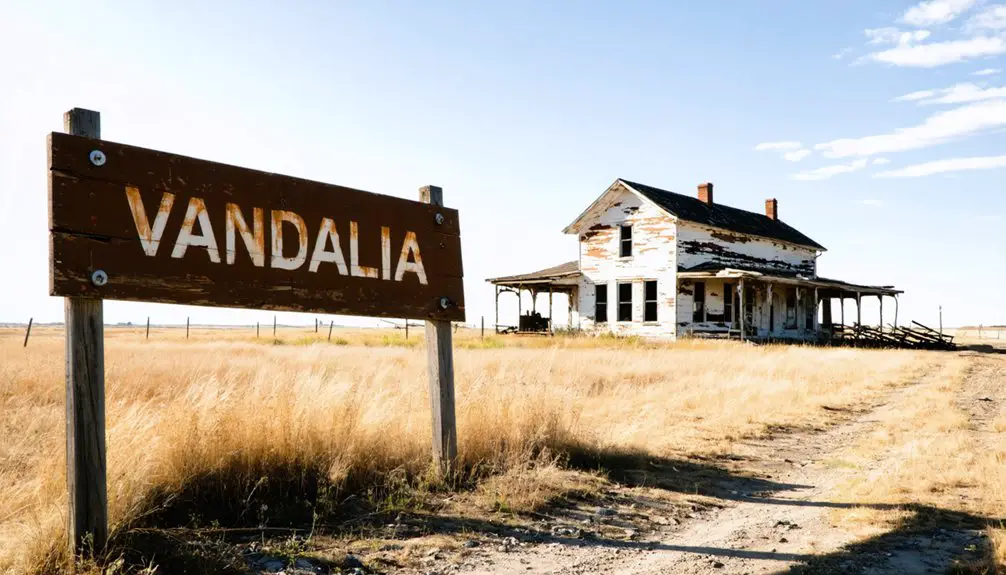
You’ll find the origins of Vandalia’s name rooted in a compelling incident involving a group of vandals or beggars who reportedly raided a Great Northern Railway survey party’s camp.
The name emerged from this local event, marking the intersection between railroad expansion and frontier challenges in Montana’s early settlement period.
While the precise etymology remains uncertain, the story has become part of Valley County’s cultural folklore, preserving the memory of early railway encounters along the Milk River.
Railway Camp Raid Story
Although historical records remain sparse, the origin of Vandalia’s name appears closely tied to Montana Central Railway operations in the early 1880s. You’ll find tales of railway conflicts and camp security measures that shaped this remote outpost during Montana’s railroad expansion era. The unprecedented speed of construction, with 650 miles built in a single season, likely contributed to the tensions and conflicts in railway camps like Vandalia.
Local accounts tell of a dramatic “Railway Camp Raid” that influenced the camp’s identity and operations:
- Camp leaders established vigilante committees to maintain order among diverse worker groups.
- Threats from outlaws and disputes between laborers created ongoing security challenges.
- Irish and Swedish immigrants formed alliances to protect their interests during construction.
These stories of conflict and resilience reflect the raw frontier spirit that defined Montana’s railway camps, where freedom and lawlessness often collided in the pursuit of progress.
Local Legends and Etymology
While most Montana ghost town names have clear historical roots, Vandalia’s etymology stems from a compelling local legend about a raid on an early Great Northern Railway survey camp.
According to local folklore, the town’s name derives from an incident where a group of vandals or beggars attacked the camp, leaving such an impression that surveyors immortalized the event in the settlement’s name.
You’ll find this story woven into the fabric of Vandalia’s frontier identity, though historical documentation remains limited.
Like many ghost town names, similar to how Keystone was renamed multiple times, the tale blends fact with mythic elements, reflecting the wild character of early Montana settlements.
The name “Vandalia” continues to evoke the untamed spirit of the region’s railway expansion era, when conflicts and lawlessness shaped the landscape.
The Brick Factory Legacy
As the cornerstone of Vandalia’s industrial heritage, the Walsh Fire Clay Products Company brick plant began operations in July 1918, quickly establishing itself as the world’s largest brick manufacturing facility of its time.
The plant’s industrial legacy transformed this rural Montana town into a bustling manufacturing hub, with brick production reaching up to 2,500 metric tons monthly.
You’ll find these remarkable features of the factory’s operations:
- Round-the-clock production with kilns running 24/7
- A dedicated railway spur built by Chicago and Alton Railroad
- Three-shift shipping schedule five days per week
The plant’s century-long operation under various owners, including its evolution into HarbisonWalker International, cemented Vandalia’s place in America’s industrial history.
Its strategic location and robust infrastructure supported sustained high-volume output that defined the region’s economic landscape.
Historic Buildings and Remnants
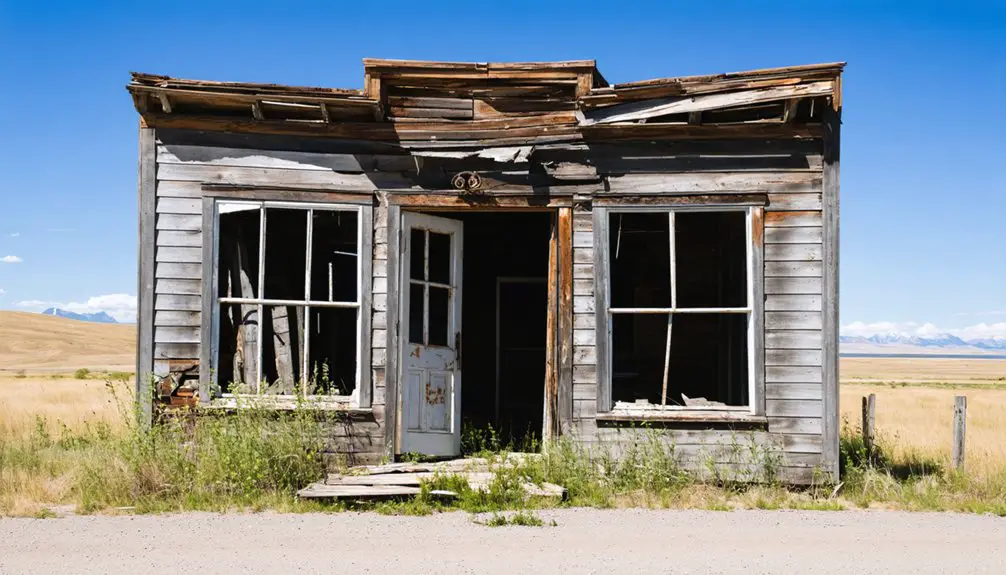
The haunting remnants of Vandalia’s historic buildings stand as silent witnesses to its once-thriving community.
You’ll find the most prominent structure, a two-story brick schoolhouse, which once educated 100 students until its closure in 1959. The building’s architectural significance has made it one of Montana’s most photographed abandoned sites. Like the preserved structures in Virginia City, these buildings offer glimpses into Montana’s rich historical past. Similar to many communities along the Milwaukee Road, the town’s abandonment accelerated after the railroad’s closure in 1980.
As you explore the ghost town, you’ll discover a few decrepit houses and abandoned gas stations with vintage pumps frozen in time since the 1970s.
While the historic preservation efforts saved the brick bank through relocation to Forsyth, most structures have succumbed to decay.
The town’s former antique store site remains recognizable by scattered wagons and pottery, while collapsed foundations mark where homes and businesses once clustered along the Milwaukee Railroad line.
Agricultural Heritage and Irrigation
From its earliest days in the mid-1800s, Vandalia’s agricultural heritage emerged alongside Montana’s broader farming expansion, transforming the region’s semi-arid landscape into productive farmland.
Montana’s pioneering spirit transformed Vandalia’s arid lands into thriving farms, forever shaping the region’s agricultural identity.
You’ll find evidence of innovative irrigation techniques through the Milk River Project, which brought life-sustaining water via 200 miles of canals to roughly 120,000 acres near Vandalia. Early settlers were part of the last agricultural frontier as they pushed into Montana’s untamed territories.
Local farmers mastered crop adaptation to overcome challenging climate conditions by:
- Growing resilient cereals like wheat, oats, and barley
- Implementing dry farming methods supplemented by irrigation
- Timing harvests precisely to avoid frost damage
The agricultural development shaped Vandalia’s growth, with extensive irrigation infrastructure from the Lake Shelburne, St. Mary Canal, and Fresno Reservoir supporting the community’s farming ventures until its eventual decline.
The Impact of Railway Development
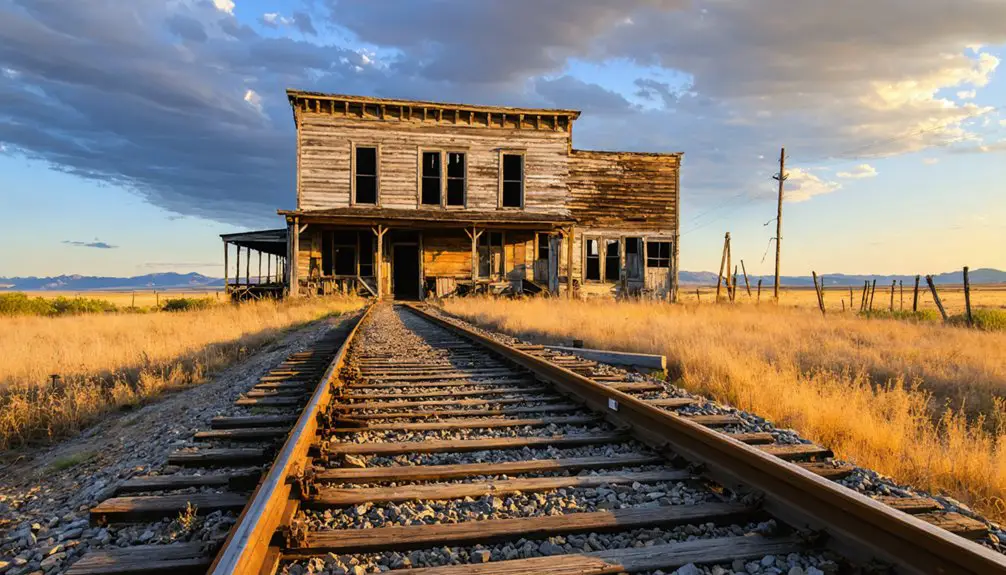
Railway development near Vandalia gained momentum in 1892 with the construction of the Butte, Anaconda & Pacific Railway (BAP), marking a shift from purely agricultural endeavors to enhanced industrial connectivity.
You’ll find that BAP’s arrival created hundreds of railway jobs, transforming the local economy as it connected essential mining operations between Butte and Anaconda. Marcus Daly established the railway to efficiently transport copper ore supplies from the mines.
The economic transformation wasn’t limited to employment alone. As the first heavy-haul electrified railroad globally by 1913, BAP revolutionized ore transport with advanced electric locomotives and regenerative braking technology. The implementation of electric operations led to significant cost savings compared to steam locomotives.
The railway’s presence spurred growth in surrounding communities, particularly Anaconda, where the population doubled in the 1890s.
While Vandalia initially thrived as a significant stop along these transportation routes, its importance gradually diminished as newer highways bypassed the town.
Exploring Modern-Day Vandalia
Modern visitors to Vandalia will find a stark contrast to its bustling railroad heyday, with only a handful of deteriorating structures marking what was once a thriving Montana community.
Time and abandonment have stripped Vandalia down to its bones, leaving only whispers of its railway glory days behind.
Today’s ghost town showcases both decay and hope through recent preservation efforts. Like Montana’s other ghost towns, dedicated preservation advocates work to stabilize and maintain the remaining historical structures.
You’ll discover:
- A two-story brick schoolhouse, once accommodating 100 students, now housing rusting machinery from the area’s oil industry past
- Gunslinger Gulch, a western-themed venue saved from foreclosure, offering lodging and events
- Scattered residential ruins that tell the story of failed homesteading dreams
While not as developed as other Montana ghost towns like Bannack or Virginia City, Vandalia’s remains offer you a raw, authentic glimpse into the boom-and-bust cycle of railroad towns.
Just watch your step – those schoolhouse floors aren’t what they used to be.
Frequently Asked Questions
Are There Any Reported Ghost Sightings or Paranormal Activities in Vandalia?
You won’t find verified ghost stories here, despite what paranormal investigations suggest. While creepy abandoned buildings might spark your imagination, there’s no documented evidence of supernatural activity in this forgotten town.
What Happened to the Residents Who Left Vandalia During Its Decline?
You’ll find former residents scattered after economic decline, with many moving to Glasgow Air Force Base for work, while others settled in nearby towns or St. Marie, adapting to new residential relocation patterns.
Can Visitors Legally Explore and Photograph the Remaining Structures?
Look before you leap – you can’t legally explore or photograph Vandalia’s structures without the private owner’s permission. There aren’t established photography guidelines, and trespassing could be dangerous and unlawful.
When Was the Last Time Vandalia Had Permanent Year-Round Residents?
While exact records aren’t available, you’ll find that Vandalia’s last residents departed during population decline before the 1970s, when remaining buildings were already abandoned and deteriorating beyond habitable conditions.
Are There Any Preservation Efforts Currently Underway to Protect Vandalia’s Remains?
You’ll find 25% of Montana’s Ghost Town license plate funds support preservation strategies here, alongside technical assistance from SHPO and upcoming grant opportunities in fall 2025 to protect remaining historical significance.
References
- https://963theblaze.com/montana-ghost-town-saved-last-minute-rescue-halts-foreclosure/
- https://montanahistoriclandscape.com/2014/06/30/valley-countys-st-marie-the-federal-imprint-part-2/
- https://montanahistoriclandscape.com/2014/06/
- https://www.youtube.com/watch?v=tYxwkDCs3o4
- https://www.mtmemory.org/nodes/view/128273
- https://en.wikipedia.org/wiki/List_of_ghost_towns_in_Montana
- https://geomorphologyresearch.com/2011/12/27/milk-river-drainage-basin-landform-origins-montana-and-alberta-usa-and-canada-overview-essay/
- https://discoveringmontana.com/rivers/milk/
- https://en.wikipedia.org/wiki/Milk_River_(Alberta–Montana)
- https://www.milkriver.ca/p/the-milk-river
